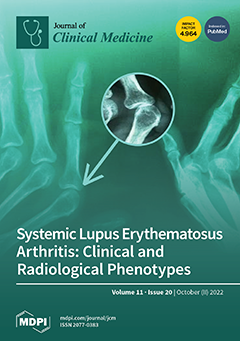Traditional approaches for male circumcision are tedious and could lead to complications such as peri-/postoperative pain, bleeding, and infection. Thus, for the first time, we investigated the surgical outcomes of recently the discovered Disposable Circumcision Anastomat Type A (Dongguan ZSR Biomedical Technology Company
[...] Read more.
Traditional approaches for male circumcision are tedious and could lead to complications such as peri-/postoperative pain, bleeding, and infection. Thus, for the first time, we investigated the surgical outcomes of recently the discovered Disposable Circumcision Anastomat Type A (Dongguan ZSR Biomedical Technology Company Ltd., China), a disposable circumcision suture device (DCSD), in terms of the operation time, surgical complexity, safety, satisfaction, and aesthetic outcomes and most importantly the prognostic factors for postoperative infection. A total of 394 individuals were circumcised, with a mean age, body mass index (BMI), stretched penile length (SPL), and penile circumference of 30.1 ± 7.05 years, 25.47 ± 4.73, 10.12 ± 1.61, and 7 ± 0.73 cm, respectively. Associated comorbidities included diabetes mellitus (6.09%), hypertension (2.03%), gout (1.02%), end-stage renal disease (ESRD, 0.25%), and HIV (0.25%). The mean operation time, average postoperative bleeding, and wound infection rate was 31.4 ± 9.96 min, 2.54%, and 9.39%, respectively. The mean VAS postoperative pain scores at D0 and D1 were 4.4 ± 2.4 and 1.9 ± 1.6, respectively. Moreover, 1.27% of subjects required reoperation, and a 2.03% rate of instrument malfunction was noted. The significant factors associated with the post-operative infection group were age (
p = 0.0313), BW (
p = 0.0081), BMI (
p = 0.0026), penile circumference (
p = 0.0343), and DM (
p ≤ 0.001). Multivariate analyses revealed only DM as a statistically significant factor (
p < 0.001). Our box–whisker plot revealed no significant difference between the HbA1c level of infection (Hb1Ac = 7.77 ± 1.39) and non-infection groups (Hb1Ac = 6.92 ± 1.84). However, a trend of higher glycemic index in the infection group was observed. Conclusively, DSCD could be an effective and safe alternative to performing circumcision. However, in the population with advanced aging, phimosis, elevated BMI, and DM (HbA1C > 9%), users should be highly cautious due to the increased risk of infection, dehiscence, and hematoma.
Full article






